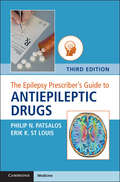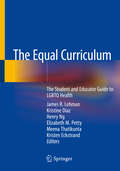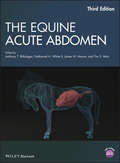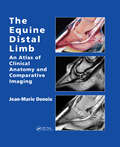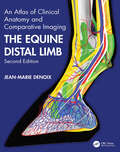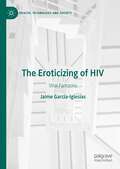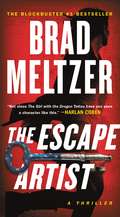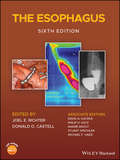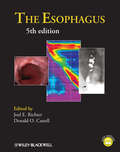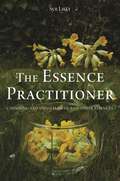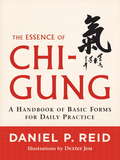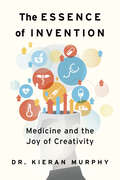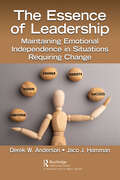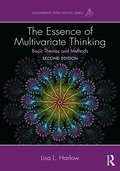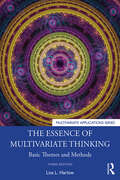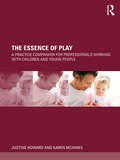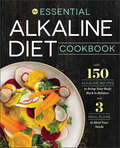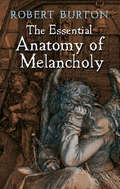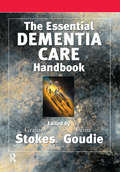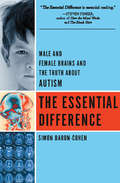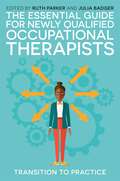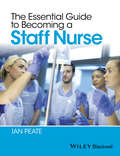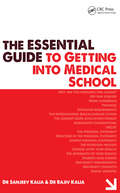- Table View
- List View
The Epilepsy Prescriber's Guide to Antiepileptic Drugs
by Philip Patsalos Erik St LouisThis essential and concise clinical reference guide serves diverse clinicians and allied health professionals who prescribe antiepileptic drugs in contemporary clinical practice. Fully updated, it features chapters on newly-approved drug brivaracetam, updated paediatric prescribing, use in particular populations including women, elderly, and patients with cognitive impairment, as well as sections on teratogenicity, pregnancy, and lactation. In full colour throughout, the guide provides comprehensive antiepileptic drug (AED) prescribing information, covering all 35 AEDs in alphabetical order. Each chapter features eight coloured sections including general therapeutics, pharmacokinetics, interaction profile, adverse effects, dosing and use, special population considerations, a summary overview, and suggested reading. Perfect for quick reference use, the guide is practical and essential for all AED drug prescribers including adult and paediatric neurologists, neurosurgeons, psychiatrists, internists, geriatricians, paediatricians, family physicians, as well as allied health professionals and resident, fellow, and student trainees in all related medical fields.
The Equal Curriculum: The Student and Educator Guide to LGBTQ Health
by Kristen Eckstrand James R. Lehman Kristine Diaz Henry Ng Elizabeth M. Petty Meena ThatikuntaThis first-of-its-kind textbook marks a revolutionary effort to reform medical education nationally by providing a comprehensive, high-quality resource to serve as a foundation for lesbian, gay, bisexual, transgender, and queer (LGBTQ) health education across multiple disciplines. Addressing the decades-long unequal weight of medical education generally offered about the care of LGBTQ people, The Equal Curriculum was created to advance clinicians' competencies in optimizing the health of LGBTQ people. This textbook is designed to be integrated into health sciences curricula and offers pointed strategies to evaluate the integration of LGBTQ health topics. Starting with a brief overview, chapters 1 through 4 cover general content that is highly relevant to all health professionals working with LGBTQ people. Chapters 5 through 12 focus on specific patient populations and clinical specialties, and chapters 13 and 14 cover special topics. Key points in each chapter are highlighted to aid in the comprehension, and case vignettes are provided throughout the textbook, allowing learners to apply the content to clinical scenarios in order to evaluate how the application of relevant knowledge may impact health outcomes. Questions similar to National Board of Medical Examiners (NBME) style are provided in most chapters to assist in the application of content. As major addition to the clinical literature, The Equal Curriculum: Student and Educator Guide to LGBTQ Health should be of great interest to health sciences instructors, medical students in their preclinical and clinical phases, and trainees from other disciplines, such as physician assistants, nurses, social workers, and public health professionals.
The Equine Acute Abdomen
by James Moore Anthony T. Blikslager Nathaniel A. White Tim S. MairWritten and edited by leading experts on equine digestive diseases, The Equine Acute Abdomen, Third Editionis the preeminent text on diagnosing and treating acute abdominal diseases in horses, donkeys, and mules. The definitive guide to acute abdominal disorders in equine patients, fully updated and revised to reflect the latest developments in the field Lavishly illustrated with more than 450 color illustrations, photographs, line drawings, and figures A companion website features video clips and images from the book available for download Provides an invaluable resource to equine surgery and internal medicine specialists, researchers, practitioners, and students who deal with colic
The Equine Distal Limb: An Atlas of Clinical Anatomy and Comparative Imaging
by Jean-Marie DenoixJean-Marie Denoix is the world's leading equine musculoskeletal system anatomist and has become one of the foremost equine diagnostic ultrasonographers. There is therefore nobody better to compile a reference atlas of the clinical anatomy of the foot, pastern and fetlock, correlated with images obtained by radiography, diagnostic ultrasonography and magnetic resonance imaging. Advanced imaging techniques require in depth knowledge of anatomy for accurate interpretation and especially when using magnetic resonance imaging this must be a 3-dimensional concept of anatomy.
The Equine Distal Limb: An Atlas of Clinical Anatomy and Comparative Imaging
by Jean-Marie DenoixJean-Marie Denoix is the world’s leading equine musculoskesletal system anatomist and has become one of the foremost equine diagnostic ultrasonographers. There is therefore nobody better to compile a reference atlas of the clinical anatomy of the foot, pastern and fetlock, correlated with images obtained by radiography, diagnostic ultrasonography and magnetic resonance imaging. Advanced imaging techniques require in-depth knowledge of anatomy for accurate interpretation and, especially when using magnetic resonance imaging, this must be a three-dimensional concept of anatomy.This new edition replaces ultrasound images and most of the radiographic and MRI images with new, updated versions and adds brand new images of extraordinarily high quality. The multiple views of each area of the distal limb provide an extremely detailed evaluation, while every part opens with an anatomical drawing by the author. Each double-page spread deals with a single dissection viewed by means of colour photographs, labelled B&W equivalents, plus x-rays, ultrasound and MRI scans as required.Diagnosis and management of distal limb lameness require a precise knowledge of the functional anatomy and biomechanics of the equine distal joints, ligaments and tendons, presented in the last chapter. The atlas is designed for maximum clarity using a generous page size and is essential for anybody involved in detailed anatomical study, complex lameness evaluation or advanced imaging techniques.
The Eroticizing of HIV: Viral Fantasies (Health, Technology and Society)
by Jaime García-IglesiasThis book examines sexual fantasies and their influence on everyday life through the stories of twenty-two men who introduce themselves as bugchasers, i.e. gay men who eroticize HIV. The author defines bugchasing, charts its history and contexts, and considers how it has changed in the age of internet and PrEP. Through the participants, their experiences and contexts, this text also theorizes about sexual fantasies, seeking to understand how people define sexual fantasies and use the internet as a space to navigate their desires, meet others, and find support. Chapters also consider the practical implications of fantasy, most notably, how fantasies influence men’s decisions around HIV prevention and care. This book speaks to renewed interest in both the AIDS crisis and the sociology of everyday life to illustrate how fantasies such as bugchasing appear, evolve, and adapt. This book will be of interest to scholars focused on queer studies, sexuality studies, gender studies, and healthcare.
The Escape Artist: A Zig And Nola Novel (Zig and Nola #1)
by Brad Meltzer<P>WHO IS NOLA BROWN? <P>Nola is a mystery Nola is trouble. And Nola is supposed to be dead. Her body was found on a plane that mysteriously fell from the sky as it left a secret military base in the Alaskan wilderness. Her commanding officer verifies she's dead. The US government confirms it. But Jim "Zig" Zigarowski has just found out the truth: Nola is still alive. And on the run. <P>Zig works at Dover Air Force Base, helping put to rest the bodies of those who die on top-secret missions. Nola was a childhood friend of Zig's daughter and someone who once saved his daughter's life. So when Zig realizes Nola is still alive, he's determined to find her. Yet as Zig digs into Nola's past, he learns that trouble follows Nola everywhere she goes. <P>Nola is the U.S. Army's artist-in-residence-a painter and trained soldier who rushes into battle, making art from war's aftermath and sharing observations about today's wars that would otherwise go overlooked. On her last mission, Nola saw something nobody was supposed to see, earning her an enemy unlike any other, one who will do whatever it takes to keep Nola quiet. <P>Together, Nola and Zig will either reveal a sleight of hand being played at the highest levels of power or die trying to uncover the US Army's most mysterious secret-a centuries-old conspiracy that traces back through history to the greatest escape artist of all: Harry Houdini. <P><b> A New York Times Bestseller</b>
The Esophagus
by Michael F. Vaezi David A. Katzka Andre Smout Stuart Spechler Phillip O. KatzTHE ESOPHAGUS The Esophagus investigates the anatomy, physiology, and pathology of the esophagus. This sixth edition, revised and updated throughout, also explores the diagnosis and treatment of various esophageal conditions. It includes treatment guidelines approved by the two largest gastroenterology societies, the ACG and AGA, as befits a work co-edited by two former presidents of those organizations. Advancements in diagnostics are presented, as are developments in the surgical and drug therapies.Presented in full colour, and boasting an unrivalled team of editors and contributing authors, The Esophagus Sixth Edition will find a home wherever the anatomy, physiology, and pathology of the esophagus are studied and taught.This book is accompanied by a website containing all the figures from the book in PowerPoint format.www.wiley.com/go/richter/esophagus6ePraise for the Fifth Edition:“There is absolutely no doubt that this edition of the textbook will maintain its status as the go-to reference for esophageal conditions, and will remain a highly utilized and clinically useful resource for novice and experienced physicians and surgeons alike.” (Gastroenterology, 1 July 2013)
The Esophagus
by Joel E. Richter Donald O. CastellThis is easily the most focused and comprehensive book available dedicated to the esophagus and its conditions, fully exploring anatomy, physiology, pathology, diagnosis, and treatment. Edited by two former presidents of the ACG and ASG, the world's two largest gastroenterology societies, the text offers approved treatment guidelines from these organizations. This new edition updates all chapters with the latest developments, highlighting advances in diagnostic techniques, and both surgical and drug treatment therapies for esophageal conditions. The new edition also features an electronic component, with searchable text and all figures available in slide format.
The Essence Practitioner: Choosing and using flower and other essences
by Tony Pinkus Sue LillyThis practical handbook covers everything you need to know to use flower and other essences effectively with clients. Sue Lilly explains what is happening energetically when essences are at work and draws on her wealth of essence knowledge to provide guidelines on: · Assessing - techniques for testing clients · Choosing - how to select appropriate essences for a range of conditions · Using - new and innovative applications of essences · Creating - different methods of creating essences and guidelines for selling them · Expanding knowledge - how essences can be linked to chakras, meridians and subtle bodies and how this knowledge can enhance practice This comprehensive guide is ideal for any student starting out or any practitioner wanting to explore new ways of using essences.
The Essence of Analgesia and Analgesics
by Raymond S. Sinatra Jonathan S. Jahr J. Michael Watkins-PitchfordThe Essence of Analgesia and Analgesics is an invaluable practical resource for clinicians giving pain relief in any clinical setting, describing the pharmacologic principles and clinical use of all available pain medications. As well as detailed overviews of pain processing and analgesic theory, sections are dedicated to oral and panteral opioid analgesics, neuraxial opioids, NSAIDs, local anesthetics, anticonvulsant type analgesics, NMDA antagonists, alpha adrenergic analgesics, antidepressant analgesics, muscle relaxants, adjuvant medications, and new and emerging analgesics. The concise format of the chapters allows for quick and easy reading and assimilation of information. Enhanced by summary tables and figures, each chapter provides an overview of a particular drug, covering chemical structure, mode of activity, indications, contraindications, common doses and uses, advantages and disadvantages, and drug related adverse events. Key references are also provided. Edited by leading experts in pain management, this is essential reading for any clinician involved in pain management.
The Essence of Chi-Gung: A Handbook of Basic Forms for Daily Practice
by Daniel P. ReidThe beneficial health effects of daily chi-gung practice have long been known in China, but in the West, chi-gung is becoming increasingly used for general well-being and to complement conventional medical treatment. The Essence of Chi-Gung is an easy-to-use workbook that teaches the fundamentals of chi-gung practice and provides a safe, basic daily regimen that can be adapted for people of all ages and physical abilities. The view in Chinese medicine is that good health is maintained by circulating and increasing chi, the vital life energy that we are all born with. In chi-gung practice, slow, rhythmic breathing is synchronized with body movements, in a way which is beneficial to both the nervous and immune systems and to overall health. This manual includes over fifty step-by-step illustrations of the warm-up exercises and movement forms.
The Essence of Invention: Medicine and the Joy of Creativity
by Kieran MurphyMeet the brilliant mavericks who invented the future of medicine and saved the lives of millions.The Essence of Invention tells the story of medical inventors who have laid the foundation for modern patient care, from the development of anaesthesia and safe surgery to the advent of vaccines against smallpox, polio, and Covid-19, and how, through creativity and persistence, they have changed the world. The same kind of energy that drove Van Gogh or the Beatles can manifest itself in medicine as inventiveness and the creation of new medical devices. The field may feel very different from what is traditionally considered a creative industry, but the fundamental motivation and aspiration to create and the conviction and resilience needed to do so are the same. Dr. Murphy celebrates the creative energy of courageous men and women, honours their unique gifts, and explains how a culture of creativity and collaboration can and must be established around them to allow their talents to take flight.
The Essence of Leadership: Maintaining Emotional Independence in Situations Requiring Change
by Jaco J. Hamman Derek W. AndersonThe world is experiencing a leadership crisis. The Essence of Leadership addresses this concern by empowering self-differentiated leadership. The authors draw on family systems thinking, foundational to family therapy, psychodynamic theory, a recognized lens on human nature, and proven process management tools. The core message explored over seven chapters is that a leader’s management of their own anxiety and the anxiety in a system has direct implications for their effectiveness in bringing change. The authors believe that leadership is mastering emotional and relational processes seeking to bring change according to clearly defined goals and ethical principles. As such, leadership is poorly defined as a cognitive-rational, economic, charismatic, democratic, data-based, or expert-driven "How to …" skill. Rather, anxiety’s flow and management greatly determine the likelihood of systemic transformation. After reading this book, leaders will be empowered with a growing understanding of the role anxiety plays in systemic change even as they are equipped to lead with less anxiety. Though the theory and practices in the book are applicable to all leaders, leadership is illustrated through numerous case studies from their extensive experience empowering leaders in both the for profit and nonprofit sectors. Callouts throughout the book, along with questions for reflection, invite the reader into deeper contemplation.
The Essence of Multivariate Thinking: Basic Themes and Methods (Multivariate Applications Series)
by Lisa L. HarlowBy focusing on underlying themes, this book helps readers better understand the connections between multivariate methods. For each method the author highlights: the similarities and differences between the methods, when they are used and the questions they address, the key assumptions and equations, and how to interpret the results. The concepts take center stage while formulas are kept to a minimum. Examples using the same data set give readers continuity so they can more easily apply the concepts. Each method is also accompanied by a worked out example, SPSS and SAS input, and an example of how to write up the results. EQS code is used for the book’s SEM applications. ?This extensively revised edition features: New SEM chapters including an introduction (ch.10), path analysis (ch.11), confirmatory factor analysis (ch.12), and latent variable modeling (ch.13) the last three with an EQS application. A new chapter on multilevel modeling (ch. 8) that is now used more frequently in the social sciences. More emphasis on significance tests, effect sizes, and confidence intervals to encourage readers to adopt a thorough approach to assessing the magnitude of their findings. A new data set that explores the work environment. More discussion about the basic assumptions and equations for each method for a more accessible approach. New examples that help clarify the distinctions between methods. A new website at https://sites.google.com/site/multivariatesecondedition/ that features the datasets for all of the examples in the book for use in both SPSS and SAS and in EQS for the SEM chapters. The first two chapters review the core themes that run through most multivariate methods. The author shows how understanding multivariate methods is much more achievable when we notice the themes that underlie these statistical techniques. This multiple level approach also provides greater reliability and validity in our research. After providing insight into the core themes, the author illustrates them as they apply to the most popular multivariate methods used in the social, and behavioral sciences. First, two intermediate methods are explored – multiple regression and analysis of covariance. Next the multivariate grouping variable methods of multivariate analysis of variance, discriminant function analysis, and logistic regression are explored. Next the themes are applied to multivariate modeling methods including multilevel modeling, path analysis, confirmatory factor analysis, and latent variable models that include exploratory structural methods of principal component and factor analysis. The book concludes with a summary of the common themes and how they pertain to each method discussed in this book. ?Intended for advanced undergraduate and/or graduate courses in multivariate statistics taught in psychology, education, human development, business, nursing, and other social and life sciences, researchers also appreciate this book‘s applied approach. Knowledge of basic statistics, research methods, basic algebra, and finite mathematics is recommended.
The Essence of Multivariate Thinking: Basic Themes and Methods (Multivariate Applications Series)
by Lisa L. HarlowFocusing on the underlying themes that run through most multivariate methods, in this fully updated 3rd edition of The Essence of Multivariate Thinking Dr. Harlow shares the similarities and differences among multiple multivariate methods to help ease the understanding of the basic concepts. The book continues to highlight the main themes that run through just about every quantitative method, describing the statistical features in clear language. Analyzed examples are presented in 12 of the 15 chapters, showing when and how to use relevant multivariate methods, and how to interpret the findings both from an overarching macro- and more specific micro-level approach that includes focus on statistical tests, effect sizes and confidence intervals. This revised 3rd edition offers thoroughly revised and updated chapters to bring them in line with current information in the field, the addition of R code for all examples, continued SAS and SPSS code for seven chapters, two new chapters on structural equation modeling (SEM) on multiple sample analysis (MSA) and latent growth modeling (LGM), and applications with a large longitudinal dataset in the examples of all methods chapters. Of interest to those seeking clarity on multivariate methods often covered in a statistics course for first-year graduate students or advanced undergraduates, this book will be key reading and provide greater conceptual understanding and clear input on how to apply basic and SEM multivariate statistics taught in psychology, education, human development, business, nursing, and other social and life sciences.
The Essence of Play: A Practice Companion for Professionals Working with Children and Young People
by Justine Howard Karen McInnesA unique companion to professional play practice! All play professionals are united in their belief that play is important for children’s development – and there are inherent characteristics of play that underpin professional play practice across contexts. Providing an overarching concept of play, drawing together the evidence base across disciplines and linking theory to practice, The Essence of Play is the ideal handbook for all those working with children. Play acts as a natural resource for children to meet physical, intellectual and emotional challenges and this book, unusually, considers play from the perspectives of children rather than adults. It provides a baseline of shared knowledge for all play professionals, exploring the fundamental value of play rather than a ‘how to’ approach to practice. It considers: the therapeutic potential inherent in play; how play reflects and promotes physical, emotional, intellectual, linguistic and social abilities; the emergence of different types of play skills and why these are important; cross-cultural patterns in play, gender, atypicality and adversity, highlighting the relevance of these issues to professional play practice; the benefits of utilising play for assessment and other professional practice issues such as ethical play practice, balancing risk with health and safety and the creation and management of boundaries. This text is designed for students and practitioners working with children across the helping professions, including early years education, play therapy, playwork, childcare, social care, nursing and allied health. Each chapter provides directed reading and small reflective tasks to encourage readers to digest key issues.
The Essential Alkaline Diet Cookbook: 150 Alkaline Recipes to Bring Your Body Back to Balance and 3 Meal Plans to Meet Your Needs
by Rockridge PressFight dietary diseases and bring pH balance back to your body with 150 Alkaline recipes.Why eat according to pH? The Alkaline Diet helps create more alkaline environments in our bodies, which can combat diet-related diseases. Serving a number of lifestyle benefits, the Alkaline Diet improves bone health, cholesterol, blood pressure, cardiovascular health, and much more. With ailment-specific recipes and a 30-day meal plan to ensure success, The Essential Alkaline Diet Cookbook makes cooking balanced, nourishing meals easier than ever.The Essential Alkaline Diet Cookbook offers:150 Satisfying Recipes that will naturally bring your system back to balance with low-sodium, low-sugar, low-fat, high-fiber, and antioxidant rich meals30-Day Meal Plan for supporting your immune system, thyroid, or kidneysAn Essential Overview of the Alkaline Diet, including a handy list of the alkaline or acidic values of nearly 200 foodsAlkaline Diet recipes include: Almond-Quinoa Muffins, Quinoa and Avocado Salad, Vegetable Potpie, Championship Chili, Lovers' Lasagna.Taste the benefits of a pH balanced diet with The Essential Alkaline Diet Cookbook.
The Essential Anatomy of Melancholy
by Robert BurtonEnglish churchman and scholar Robert Burton (1577-1640) was a passionate student of medicine, history, literature, and science — the whole of human knowledge. This witty and eloquent genius devoted most of this life to writing The Anatomy of Melancholy, one of the richest, most inexhaustible books in the English language.Ostensibly an elaborately systematized medical treatise dealing with various morbid mental states — their causes, symptoms, and cures — the Anatomy is much more: a compendium of memorable utterances on the human condition in general, compiled from classical, scholastic, and contemporary sources. For this edition, the editors carefully selected passages of the most psychological and general interest, eliminating the nonessential material but retaining the incomparable humor, eccentric charm, imagination, and thought-provoking appeal of the original.In short, readers will find here the essence of Burton's vast book — the passages that, according to noted scholar W. H. D. Rouse, reveal the author's "eternal freshness, his own ingenuous interest, [and] his boyish delight in a good story."
The Essential Brain Injury Guide
by Brain Injury Association of AmericaThis manual provides a body of knowledge that can be utilized in preparation for brain injury specialist certification.
The Essential Dementia Care Handbook: A Good Practice Guide
by Fiona GoudieReplacing the successful "Working with Dementia", this edition draws together many new ideas and practical approaches from a wide variety of professionals working at the leading edge of the provision of services to people with dementia and provides a comprehensive account of current best practice. Beginning with the diagnosis of dementia and other problems associated with aging, this book considers assessment, the person centered model of dementia, rehabilitation and therapy. It outlines practical interventions, illustrated with case studies that provide a stimulating insight into contemporary understanding and practice. Nursing staff, occupational therapists, residential care workers, social workers and all those in day-to-day contact with elderly people will be inspired by this vital handbook for all care staff.
The Essential Difference: Male and Female Brains and the Truth About Autism
by Simon Baron-CohenWe all know the opposite sex can be a baffling, even infuriating, species. Why do most men use the phone to exchange information rather than have a chat? Why do women love talking about relationships and feelings with their girlfriends while men seem drawn to computer games, new gadgets, or the latest sports scores? Does it really all just come down to our upbringing? In The Essential Difference, leading psychologist Simon Baron-Cohen confirms what most of us had suspected all along: that male and female brains are different. This groundbreaking and controversial study reveals the scientific evidence (present even in one-day-old babies) that proves that female-type brains are better at empathizing and communicating, while male brains are stronger at understanding and building systems-not just computers and machinery, but abstract systems such as politics and music. Most revolutionary of all, The Essential Difference also puts forward the compelling new theory that autism (and its close relative, Asperger's Syndrome) is actually an example of the extreme male brain. His theory can explain why those who live with this condition are brilliant at analyzing the most complex systems yet cannot relate to the emotional lives of those with whom they live. Understanding our essential difference, Baron-Cohen concludes, may help us not only make sense of our partners' foibles, but also solve one of the most mysterious scientific riddles of our time.
The Essential Guide for Newly Qualified Occupational Therapists: Transition to Practice
by Nick Pollard Sean O'Sullivan Ruth Parker Julia Badger Ruth Van Weyden Dawn Simm Melanie Elliott Sara Brewin Jo McKee Kate Sheehan Dr Theresa BaxterStarting out in practice can be difficult and confusing. This guide for newly qualified occupational therapists provides an authoritative overview of what to expect in your role and work settings, and is full of practical guidance on how to make a good start to a successful practice. With chapters by experienced practitioners in the field, it offers insights into work in paediatrics, mental health, learning disability and the acute hospital setting. Vital information is also included on difficult aspects of practice such as legislation and data protection. It signposts sources for support and resources for furthering techniques in individual areas of work. Most importantly, the book offers tips for managing a busy workload, while building the positive relationships and resilience needed for a successful career in the occupational therapy.
The Essential Guide to Becoming a Staff Nurse
by Ian PeateWritten specifically for graduating students and newly registered nurses, this essential handbook will help you navigate the transition from student to registered practitioner. Providing you with the key knowledge to help consolidate your degree course, The Essential Guide to Becoming a Staff Nurse will enable you to become an autonomous and accountable practitioner. Covering everything the newly registered nurse needs to know, this handy book explores: How to get the job you want The role and function of the staff nurse Accountability and delegation Working with patients and their families Becoming a manager Continuing professional and personal development With activities, practical hints and tips throughout, this accessible aide-memoire will provide indispensable support for newly registered nurses in all fields.
The Essential Guide to Getting into Medical School
by Rajiv KaliaThis is a concise guide to getting into medical school. It covers everything you need to know without the long-winded explanations found in other books and online. The Essential Guide to Getting into Medical School prepares you for all eventualities, so you can be ready for every aspect of your application and address any shortcomings you may have which may otherwise hinder your chances. It offers helpful tips, tactics, questions and warnings to assist with decision making and personal preparedness. This book is ideal for students of any age, from GCSE onwards, including those applying as postgraduate students. It is also highly recommended for international students wanting detailed advice on how to secure admission.
